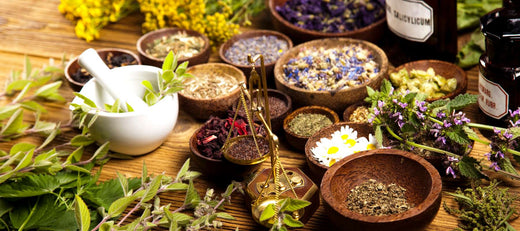Wormwood (Artemesia absinthum) is a woody perennial with a long history of use in natural medicine. You may know it as an ingredient in the alcoholic beverage Absinthe and other spirits like vermouth. The leaves and flowers of wormwood contain an essential oil with a potent fragrance that repels insects. This oil also contains a neurotoxin, thujone, which has been used as an anti-parasitic for centuries.

This plant is easy to grow and propagate, but some of its properties make it a plant to grow with caution. It should not be added to compost because the fragrance that keeps away insects will also repel earthworms. It can be poisonous to pets, and should never be used by a pregnant woman since it can cause miscarriage. As long as you understand the risks, this is a highly valuable herb to include in your survival medicinal garden.
Besides as an ingredient for Absinthe, wormwood has been used since the times of ancient Greece as an anti-parasitic for expelling worms (hence the name). Wormwood has potent anti-inflammatory properties that have been used to treat wounds and arthritis. It contains anti-bacterial and anti-fungal properties. It has also been used to help with digestion, relieving bloating and cramps and recent research shows it has the potential to treat cancer.
How to Grow Wormwood From Seed
Wormwood is not a plant you will likely find at your local garden center, but it is simple to grow from seed. It can be grown outdoors or in planters. Choose a sunny area with moderately fertile, well-drained soil. Soil drainage is very important. This plant is drought-tolerant once it is established and needs no additional fertilizer.
Wormwood seeds are very tiny, so take care to keep track of them, especially if sowing outdoors. These seeds require light for germination, so sow them on the surface of the soil and use a spray bottle to water the seeds into the soil, rather than soaking the area with a hose or watering can.
Sow seeds indoors in starter pots about 6 to 8 weeks before the last frost, or sow directly outdoors after any chance of frost. The ideal germination temperature for wormwood is between 55 and 65 degrees Fahrenheit. Seeds can take anywhere from 10 to 21 days to germinate.
Once mature, wormwood grows into a bushy clump reaching up to 3 feet tall and 2 feet wide. Prune regularly to encourage bushy growth. The ideal growing temperature for this plant is around 70 to 77 degrees Fahrenheit so you may need to choose an area with some shade in the main heat of the afternoon.
Some Things to Consider When Planting
Wormwood is a solitary plant and can inhibit the growth of neighboring plants. Keep other plants at least 18 to 24 inches away from wormwood. Neighboring edible plants can absorb some of the chemical properties of wormwood from the soil, so pay attention to this when choosing a location. It is a prolific re-seeder, so if you do not want the plant to invade the rest of your garden, be sure to cut it back before it has a chance to go to seed. If you choose to grow your wormwood in pots, you should overwinter the pots indoors as there is a risk of freezing the roots and killing the plant if left outdoors.

This plant is toxic to humans, dogs, and cats, so make sure the plant will not be encountered by those it might harm. This toxicity can benefit your garden by repelling ants, slugs, cabbage loopers, hornworms, and carrot flies. You can brew a tea of wormwood leaves to spray on plants as a natural insecticide but do not use it on edible plants. Use gloves when handling as its essential oils may cause some skin irritation.
Harvesting and Using Wormwood
Once your wormwood plants are established and flowering they can be harvested regularly, however, this usually occurs in the second year of growing. Harvest when the plant is flowering from June to September when the ingredients in the plant are at their highest. Cut non-woody branches and flowers and lay them out or hang them somewhere warm, out of the sun, to dry.
The dried leaves and flowers of the wormwood plant can be stored for a long time in airtight jars and be used to make medicinal tea. You can also preserve wormwood for a very long time by making a tincture with neutral alcoholic spirits.
Because wormwood contains toxic ingredients people with certain medical conditions should not take wormwood. Those include pregnancy or breastfeeding, kidney disease, heart disease (particularly if using blood thinners), epilepsy or seizure disorders, and allergies to members of the Asteraceae family (ragweed, asters, marigolds, and daisies). As with any natural remedy, consult with your doctor before using. None of these remedies are recommended for long-term use. We are not physicians and this information is provided for educational purposes only.
Wormwood Tincture

One popular way to use wormwood is to create a tincture. 20 drops taken 2 to 3 times a day for up to 2 weeks can help as an anti-parasitic or to relieve pain and inflammation.
- Fill a small glass jar approximately 1/3 of the way with dried wormwood leaves
- Cover the leaves with a high-proof neutral alcoholic beverage like vodka (a non-alcoholic option is apple cider vinegar).
- Seal the jar and shake well to ensure leaves are saturated with alcohol
- Leave to sit in a cool, dry place for at least 6 weeks, shaking a couple of times per week
- Strain the liquid into an amber glass dropper bottle and make sure to label and date
If stored in a dark place, the tincture should last 1 to 2 years. If using vinegar, use the tincture within 6 months.
Wormwood Tea
Steep 1/2 to 1 teaspoon of dried wormwood leaves in 1 cup of hot water for about 5 minutes. Wormwood is very bitter so add some honey and peppermint to make it more palatable. Wormwood tea is good to help with upset stomach and internal parasites.
Wormwood Poultice
To treat rashes and wounds, you can make a poultice of wormwood leaves. Steep wormwood leaves in hot water as if making tea. Allow the leaves to cool and apply to the affected area for inflammation relief.
A Valuable Addition to Your Herbal Apothecary
In our ongoing mission to help our customers be self-sufficient and prepared for whatever might happen, we added wormwood to our seed selection. This plant has been a valued natural remedy for centuries and is considered by modern herbalists to be a “must-have” in an apothecary garden. When grown and used correctly, you can take advantage of the many benefits of this ancient herb.
























